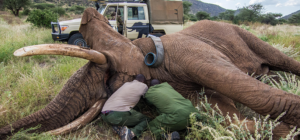When you glance into the eyes of an elephant, you will quickly realize that the animal staring back at you is a highly intelligent being; one who possesses an intricate blend of emotions, cognitive skills, and an uncanny ability to adapt and survive in its environment.
Examples of complex behaviors in elephants are many, but take for instance the remarkable way they communicate with one another. Through a series of distinctive, low-frequency rumbles [1], elephants can transmit messages over vast distances, sharing valuable and specific information about potential threats, food sources, and even the location of family members. They also possess other amazing mental abilities, including an incredible capacity for memory. This superpower allows them to navigate complex migratory routes, remember life-saving water sources, and recognize long-lost companions after years apart [2].

With a brain three times the size of a human’s and with three times as many neurons [3], elephants’ capacity for complex thought and behavior is still not fully understood (Photo: Jane Wynyard / Save the Elephants)
At the forefront of the quest to unravel the enigma of elephant behavior is Save the Elephants [5], a pioneering organization that has been dedicated to the conservation of wild African elephants for three decades. Through innovative research, steadfast commitment, and collaborations with partners like Colossal, Save the Elephants has been leading the charge to solve the mysteries surrounding elephants and conserve these iconic creatures for generations to come.
A Cause Ignited By Tragedy

Save the Elephants is helping pioneer new elephant monitoring through aerial surveys (Photo: Naiya Raja/ Save the Elephants)
The remarkable story of Save the Elephants begins with the pioneering work of Dr. Iain Douglas-Hamilton, a distinguished conservationist who now sits on Colossal’s Conservation Advisory Board. In the 1980s, Dr. Douglas-Hamilton revolutionized the way elephants were studied and counted by meticulously recording their numbers from the air using low-flying aircraft. His groundbreaking approach would reveal to the world the horrifying extent of poaching across Africa and the devastating impact it was having on elephant populations.
The sobering results of his 1989 continental census [5] brought the gravity of the elephant crisis to the public’s attention, sparking global outrage and prompting urgent calls for action. Dr. Douglas-Hamilton’s findings played a pivotal role in the passing of the international ban on ivory by CITES, marking a turning point in the fight against poaching and the illegal wildlife trade.
Driven by his passion for protecting these gentle giants, Dr. Douglas-Hamilton founded Save the Elephants in the early 1990s to continue his mission of reversing the downward trend in elephant populations and ensuring their survival for generations to come.

Dr. Iain Douglas-Hamilton, Founder of Save the Elephants & Colossal Conservation Advisor (Source: Save the Elephants)
Since its inception, Save the Elephants has been characterized by its unwavering dedication to elephant conservation. Through a combination of scientific research, community outreach, and tireless advocacy, the organization has played a vital role in shaping the global response to the multifaceted threats facing elephants. Its collaborative approach has fostered partnerships with other organizations, enabling Save the Elephants to leverage technology and innovation in their pursuit of a brighter future for these iconic giants.
Today, Save the Elephants stands as a beacon of hope and inspiration for conservationists around the world. Its story serves as a powerful reminder of what can be achieved when we unite in a common cause and work together to protect the natural wonders that grace our planet.
Uniting Innovation and Conservation
For more than three decades, Save the Elephants has been instrumental in advancing our understanding of elephant behavior, ecology, and conservation through its innovative and impactful projects. By focusing on a combination of research, protection, and community outreach, the organization has achieved remarkable success in various aspects of elephant conservation, thanks in part to its collaborations with partners like Kenya Wildlife Service (KWS) and the Kenya Wildlife Research & Training Institute.
One of their key initiatives has been the pioneering use of GPS tracking technology to study the movement patterns and behavior of elephants in the wild. By fitting individual elephants with GPS collars, Save the Elephants has collected invaluable data on migratory routes, habitat preferences, and social interactions. This information has been vital in informing land-use planning, creating wildlife corridors, and developing effective strategies to mitigate human-elephant conflict.

GPS collaring is a key project pioneered by Save the Elephants (Photo: Jane Wynyard / Save the Elephants)
In the fight against poaching, Save the Elephants has been at the forefront of collaborative efforts to protect elephants from the illegal ivory trade. By working closely with local communities, law enforcement agencies, and international partners, it has helped to dismantle poaching networks, disrupt trafficking routes, and support the training and equipping of anti-poaching units. Since 2013, Save the Elephants and their partner the Wildlife Conservation Network granted over 30 million dollars to a network of over 150 partners in 44 countries via their Elephant Crisis Fund. These coordinated efforts have played a significant role in reducing the number of elephants lost to poaching each year.

Save the Elephants’ Security Officer, Chris Leadismo (Photo: Jane Wynyard / Save the Elephants)
Save the Elephants also believes that working with and empowering local communities is crucial to the long-term success of conservation efforts. Through its education and outreach programs, they have provided scholarships to students, supported schools in remote areas, and conducted workshops to raise awareness about elephant conservation. The nonprofit has also embraced novel and creative approaches to reducing human-elephant conflict, like its Elephants and Bees Project. This ingenious initiative utilizes beehive fences around farmland to deter elephants from entering, since elephants are naturally afraid of bees. Not only does this solution protect farmers’ crops, but it also provides local communities with an additional source of income from honey production, fostering a mutually beneficial relationship between humans and elephants.
Pushing the Frontiers of Elephant Research
Colossal is thrilled to be partnering with Save the Elephants to embark on an ambitious project that will once again push the frontiers of elephant research. By harnessing the power of cutting-edge technologies, our collaboration seeks to transcend the limitations of traditional field research and data collection methods to deepen our understanding of these awe-inspiring creatures.
For generations, wildlife researchers have faced the challenges posed by human-made observations. Sending individuals to the field for data collection can strain the budgets of nonprofit organizations, while the resulting data often falls victim to imperfect results. This is due in part to the biases that inevitably emerge during human observation. As different observers may interpret and record behaviors differently, inconsistencies can arise in the data collected, leading to potentially flawed or incomplete conclusions. Furthermore, the mere presence of humans in the field can unintentionally disrupt animals’ natural behaviors, further distorting results and obstructing the pursuit of accurate insights into their lives.
Our groundbreaking collaboration aims to shatter these long-standing barriers by leveraging drone technology and advanced machine learning algorithms. Firstly, drones fitted with high-resolution and infrared cameras with cutting-edge sensors will be deployed into the wild to track and record standardized data on elephants. This innovative approach will empower the Save the Elephants team to gather more comprehensive data while minimizing disturbance to the elephants themselves. In taking this approach, the biases associated with human observation are eliminated while simultaneously expanding the breadth of data collection.

Drone footage of elephants for advanced behavior tracking project (Source: Save the Elephants)
Following data collection, machine learning models will be developed, trained, and employed to analyze the wealth of information captured by the drones. These powerful algorithms will help reveal previously inaccessible insights and ensure a consistent, objective approach to data interpretation. The machine learning models will be capable of tracking specific behaviors, distinguishing individual elephants within a herd, and, ultimately, monitoring any elephant throughout time and space.
By refining our approach to data collection and analysis, we will gain an unprecedented understanding of elephants. Understanding the giants better will pave the way for more effective conservation strategies and a brighter future for elephants around the world.
Protecting Elephants Together
From its very beginning, Save the Elephants has been a champion of blending innovative technology with unwavering conservation efforts to secure a brighter future for one of Earth’s most awe-inspiring creatures. Now, it is once again embracing cutting-edge technologies, revolutionizing the field of elephant research and taking our understanding of these majestic animals to new heights.
We are thrilled to be a part of Save the Elephant’s groundbreaking efforts, and we wholeheartedly invite you to join us in supporting its vital work. Visit their website to explore its diverse initiatives and discover the numerous ways you can contribute. Whether it’s through making a donation or simply spreading the word by sharing their stories with friends and family, your support is invaluable in securing a better future for elephants around the world.
In today’s rapidly changing world, as our planet’s wildlife faces mounting challenges, it’s more crucial than ever for us to rally behind organizations like Save the Elephants. By standing together, we can create a tangible impact on the lives of these magnificent creatures and safeguard their existence for generations to come. United in our passion for conservation, we have the power to forge a better future for elephants and the rich biodiversity they represent.
References
- “Elephant Communication: The Power of Rumbles.” Save the Elephants, https://www.savetheelephants.org/project/the-power-of-rumbles/.
- “Elephant Memories May Hold Key to Survival.” ScienceDaily, ScienceDaily, 12 Aug. 2008, https://www.sciencedaily.com/releases/2008/08/080811200337.htm.
- Herculano-Houzel, Suzana, et al. “The Elephant Brain in Numbers.” Frontiers, Frontiers, 27 May 2014, https://www.frontiersin.org/articles/10.3389/fnana.2014.00046/full.
- Mumby, Hannah S., and Joshua M. Plotnik. “Taking the Elephants’ Perspective: Remembering Elephant Behavior, Cognition and Ecology in Human-Elephant Conflict Mitigation.” Frontiers, Frontiers, 26 July 2018, https://www.frontiersin.org/articles/10.3389/fevo.2018.00122/full.
- Save the Elephants, https://www.savetheelephants.org/.



